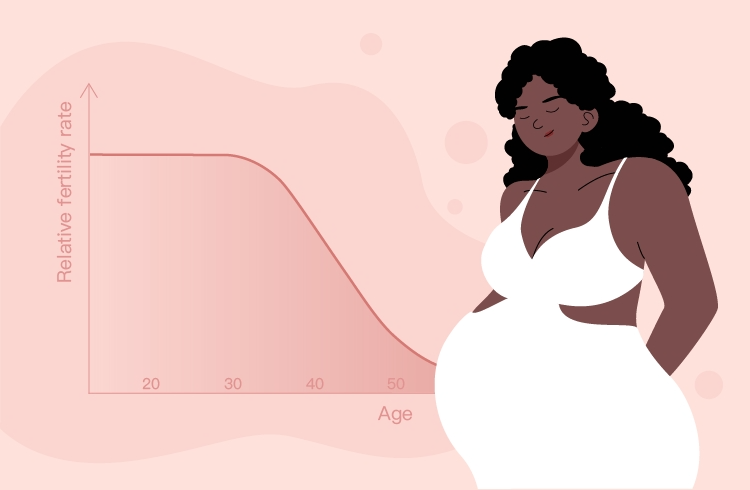What Is Prolapse?
Uterine prolapse, a condition more common than many people realize, occurs when the pelvic floor muscles and ligaments weaken, causing the uterus to descend from its normal position and protrude into the vaginal canal.
This condition is more common among women who have experienced multiple childbirths, gone through menopause, or engaged in activities that strain the pelvic muscles, such as heavy lifting or chronic coughing.

The condition can vary in severity, with some individuals experiencing mild symptoms, while others might face more disco mfort and a significant impact on their quality of life.
The Causes of Prolapse
1. Increased Age
Prolapse happens more often as we get older. That's because our body's support system weakens over time, especially the muscles in the pelvic area.
2. Giving a Birth
Also, after giving birth, the muscles around the uterus can become weaker, making it more likely for the uterus to sag or move out of place. It's like how muscles can stretch after doing lots of exercise – sometimes, they need extra care and support.

What Happens If You Ignore a Prolapsed Uterus?
Ignoring a prolapsed uterus can have serious consequences for a woman's health and well-being. A prolapsed uterus occurs when the pelvic floor muscles and ligaments become weak, leading to the descent of the uterus into the vaginal canal or beyond. If left untreated or ignored, several complications may arise:
1. Increased Discomfort and Pain
Ignoring the signs of a prolapsed uterus can significantly impact your comfort and health. The condition can cause constipation, leading to discomfort and difficulty in maintaining regular and painless bowel movements. As the condition progresses, these symptoms may become more pronounced, affecting daily activities and quality of life.
2. Fecal Incontinence
A prolapsed uterus can cause problems with bladder function, leading to urinary incontinence, difficulty emptying the bladder, or recurrent urinary tract infections. Ignoring these symptoms may contribute to the development of more severe urinary issues.
3. Sexual Intercourse Pain
Additionally, you may experience discomfort or pain during sexual intercourse due to changes and sensitivities in your pelvic floor, and the impact on body image and self-esteem can lead to a decline in sexual satisfaction.

4. Bowel Dysfunction
The descent of the uterus can also impact the functioning of the rectum and bowel movements. Constipation, difficulty emptying the bowels, and fecal incontinence may occur, further impairing a person's digestive health.
5. Complications During Pregnancy and Labor
For women of childbearing age, a prolapsed uterus can pose risks during pregnancy and labor. Ignoring the condition may increase the likelihood of complications, such as difficulty delivering the baby or an increased risk of requiring a cesarean section.
6. Increased Risks to Infections
As well as this, neglecting a prolapsed uterus could heighten the risk of urinary or reproductive tract infections, causing further discomfort and health complications.
7. Decreased Fertility
Prolapsed uterus may contribute to a decrease in fertility, particularly for women of childbearing age. The descent of the uterus can impact the normal positioning of reproductive organs and potentially interfere with the natural processes of conception and pregnancy.
Does Uterine Prolapse Require Treatment?
Uterine prolapse typically requires attention and treatment. Unfortunately, once the condition has developed, it won't resolve on its own. However, various treatment options exist to manage and alleviate symptoms associated with uterine prolapse. Lifestyle changes, such as pelvic floor exercises like Kegels, weight management, and avoiding heavy lifting, can help reduce symptoms or slow the progression of mild cases. For more severe instances, medical interventions like pessaries, which are supportive devices inserted into the vagina, or surgical procedures might be recommended.
How to Prevent It from Getting Worse?
1. Do Kegel Exercise
One proactive way to guard against uterine prolapse is by engaging in Kegel exercises. These exercises are designed to strengthen the pelvic floor muscles, which provide vital support to the uterus, bladder, and bowel. Regular practice of Kegels can enhance muscle tone in the pelvic area, contributing to better support for the reproductive organs and potentially reducing the risk of uterine prolapse.

Kegel exercises involve contracting and relaxing the muscles used to control urinary flow. These simple exercises can be performed discreetly, and their benefits extend beyond preventing prolapse. By incorporating Kegels into your daily routine, you're not only fortifying your pelvic floor muscles but also enhancing bladder control, supporting postnatal recovery, and potentially improving sexual function. One way of making Kegels more achievable is by using the Femometer Lilac Kegel smart trainer, a smart device that visualises your progress and gives you real-time feedback.
2. Weight loss
Maintaining a healthy weight is crucial in reducing the risk and managing symptoms of uterine prolapse. Excess weight places additional strain on the pelvic floor muscles and ligaments, exacerbating the condition.
3. Avoid constipation
Constipation can worsen the symptoms of uterine prolapse by placing undue stress on the pelvic area during bowel movements. To prevent constipation, ensure a fiber-rich diet comprising fruits, vegetables, and whole grains, which promote regular bowel movements. Staying hydrated and engaging in physical activity can also aid in maintaining bowel regularity and reducing the strain on pelvic muscles.
4. Using a pessary
A pessary is a removable device inserted into the vagina to support the pelvic organs and alleviate prolapse symptoms. Available in various shapes and sizes, a pessary is fitted by a healthcare professional and works by providing additional support to the weakened pelvic structures. While it's a non-invasive option for managing mild to moderate cases of uterine prolapse, regular check-ups are essential to ensure its proper placement and effectiveness.
5. Surgery for uterine prolapse
In severe cases or when conservative treatments prove ineffective, surgical options might be considered. Surgery for uterine prolapse aims to repair and support the weakened pelvic structures. Procedures may include uterine suspension or hysterectomy (removal of the uterus). However, surgery is typically reserved for cases that significantly impact a person's quality of life and doesn't always guarantee a complete cure.
These complementary approaches, along with Kegel exercises, form a comprehensive strategy to manage uterine prolapse. Consulting with a healthcare professional is crucial to determine the most suitable treatment plan tailored to individual needs and the severity of the condition.
This article is the original creation of Femometer. All rights reserved by Femometer Inc. To reproduce, distribute, or reference the content, please reach out to us in advance to prevent any potential legal issues. Copyright © Femometer Inc.











